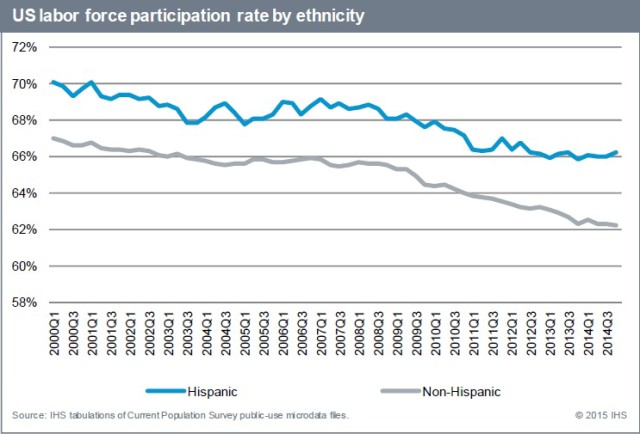
In this Feb. 13, 2015 photo, construction workers David Rager, right, and Shawn White frame the upper floor of a two-story custom home being built in Orlando, Florida. (AP Photo)
From 2020 to 2034, about 14 million new jobs will be created in the United States and 75 percent of them—approximately 11 million—will be filled by Hispanics.
In the nearer future, over the next five years, Hispanics are expected to fill 40 percent of all new jobs.
A wave of baby boomer (people born between 1946 and 1964) retirements, and a younger faster-growing Hispanic population are driving those numbers, according to a new report from the research group IHS Economics.
“People think Hispanics are going to take three of every four jobs but a lot of what’s going on is replacing a lot of retiring baby boomers,” said study author and IHS Global Insight economist James Gillula. “So, in terms of new entrants to the work force, there will be a lot more job opportunities than those 14 million because there are a lot of people that need to be replaced.”
 Many of those job gains are likely to be in construction, health services, leisure and hospitality, and professional and business services, sectors that currently employ many Hispanics and will presumably continue to offer more job opportunities.
Many of those job gains are likely to be in construction, health services, leisure and hospitality, and professional and business services, sectors that currently employ many Hispanics and will presumably continue to offer more job opportunities.
Hispanics now account for 16 percent of the U.S. labor force. By 2034, that number will have risen to 23 percent, according to the report.
Several major industrialized countries in Europe and Japan face a slowdown in labor force growth in the long term, but immigration could help offset those projected losses in the United States.
“I think an important underlying theme of the report is that immigration is important for continued U.S. economic growth,” Gillula said. “Given the dynamics of the aging of the non-Hispanic population, in order to have continuing economic growth at the levels we’ve experienced, we need some level of continuing immigration to add to the labor force growth.”
Continuing to attract immigrants doesn’t appear to be a problem. While the debate over the issue continues–Republican lawmakers are trying to block President Barack Obama’s executive actions on immigration–the United States remains the destination of choice for 80 percent of all migrants from 10 Latin American countries, according to the report.
And they are likely searching for greater economic opportunity and the improved quality of life that these future new jobs could provide.






















The invasion has been going on for 40 years plus. When we want to buy American we buy products made by illegal so called workers. Union mostly, but illegal. We sponsor people from India and others and leave nothing for us. Granted, our kids are better at parties and are fed unreal ideas from our hippie union teachers(another sad story–tenure). Anyone that thinks America is on the rise is foolish. We did good, Hispanics, Russians, Muslims, Africans and stupid programed kids that never had a family will erode everything. We had a brutal battle to survive Carter. We will not make it past Obama. We are just waiting to die.
Ignorance is not an excuse! Educate yourself. Immigrants have served the USA well and continue to make the USA greater!
Mel: Have you served in our Military!
According to data from the Department of Defense, more than 65,000 immigrants (non-U.S. citizens and naturalized citizens) were serving on active duty in the U.S. Armed Forces as of February 2008. Since September 2001, U.S. Citizenship and Immigration Services (USCIS) has naturalized more than 37,250 foreign-born members of the U.S. Armed Forces and granted posthumous citizenship to 111 service members.
The current presence of immigrants in the military has a number of historical precedents. According to USCIS, the foreign born composed half of all military recruits by the 1840s and 20 percent of the 1.5 million service members in the Union Army during the Civil War.
14.2 % of immigrants in the military are Hispanic. When they list immigrants in the military it’s mostly overseas in another country so of course they’re going to hire immigrants. Immigration in the Military predominantly Canadian, Filipinos and Puerto Rica. I would know as I’ve been an operations officer for many years from The Syndicate to Ramstein in Germany. We’ve seen it all!
I feel sorry for you.
It sounds like you live in fear of a president that supposedly by now should’ve taken all your guns, impose sharia law
taken the country into a further worst depression and impose communism in the US. Or you’re simply another bigot in the republican
agenda who has been brainwashed with hatred and fear, holding on to your guns waiting for doomsday and blaming anyone that’s not of your kind for the problems in this nation (sort of what Hitler did).
My friend let me remind you that hispanics are a strong workforce in the US because of their dedication, their relatively young population
and when it comes to hiring, employers prefer a bilingual hispanic specially in the customer service and retail industry.
The economy is the best we’ve had in the last decade, unemployment rate is at an all time low, consumer confidence is at a really good fit because of the national saving rate being around 6% (people have a bit more money to save) People are insured which is great to avoid expensive medical bills; people can go to the doctor without creating more debt for themselves thus helping the economy
but FOX won’t tell you this tho.
good luck
As Of 2008, The Highest Percentage Of Foreign-Born Military Personnel Was From Latin America and The Caribbean. According to the Migration Policy Institute, “Latin America and the Caribbean accounted for the largest percentage of the foreign born [military personnel], followed closely by Asia. Foreign-born military personnel from Latin America and the Caribbean constituted 38.7 percent (23,926) of all the foreign born in the armed forces while 35.9 percent (22,226) were from Asia.” [Migration Policy Institute, 5/08
As Of 2008, Nearly 11% Of Individuals Serving In The Armed Forces Were Of Hispanic Origin. According to the Migration Policy Institute, “Nearly 11 percent of those serving in the armed forces are of Hispanic origin. Soldiers of Hispanic origin accounted for 10.5 percent (142,318) of the 1,361,458 men and women serving in the armed forces as of February 2008. Hispanics made up 13.9 percent (45,551) of the 327,680 men and women in the navy; 12.6 percent (23,813) of the 188,511 serving in the marines; 10.8 percent (56,078) of the 520,386 in the army; and 5.2 percent (16,876) of the 324,881 air force personnel.” [Migration Policy Institute, 5/08]
Excellent “Ignorance is not an excuse! Educate yourself”, Not a Native American? You’re an Immigrant.
“Native Americans” emigrated from Siberia.
I let you know that America has three division North, Central and south.
Who gave you the right to pretend be the only Americans?
Americans are all people living and this big continent, not only the f.. natives North American. So, is right to say that the Latin American immigrants have built this country for decades and will continue doing it.
The only true Americans are the one’s that were born here. If you aren’t a citizen, you need to leave. Don’t leach off of our country’s benefits and freedom that the true Americans worked so hard for.
So why have a border then? America can just take over Mexico. What the writer of this piece fails to
explain is that if economy gets better AND the money doesn’t flow back to Mexico.
Let young men and women abroad come in to work, pay tax and feed retirees.No wonder Mr.O stops all deportations.